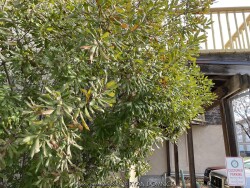

Northern Bayberry, is also known as Myrica pennsylvanica


Nandina domestica is also called "Nandina" or "Heavenly Bamboo" despite not spreading or being related to bamboo at all. It is native to warm temperate climates in China. Bamboo-like foliage is very attractive with new growth emerging coppery peach with shades of pink and red in spring. During the summer, the foliage maintains a glossy deep to medium green color with no pest problems. White flowers appear which eventually turn into red fruits in the fall. Most birds do not like the fruit so they persist very well into winter down to about 0° F before freeze-drying to a reddish brown color and falling off. Often around Christmas time, the berries make a spectacular show combining classic colors of red and green in the winter landscape. The berries can be poisonous to some birds if they eat too many and all other food sources are depleted. This is a problem in your yard, please remove the fruits in the winter or before we have an arctic blast in which birds get desperate and will eat anything. The foliage is evergreen down to about -5° F and if colder, will simply become a deciduous shrub that year. If winter temperatures reach -10 or with strong winds, nandina will die to the ground like a perennial and come up from the base in April. In some parts of the country where winterkill never happens, nandina are invasive. (fruits spread by birds) This is likely in the Southeast and Texas south of zone 8b with plenty of rainfall. In those areas nandina will slowly take over the forest and displace native plants. There are many fruitless cultivars that can be used if invasiveness is a problem. In Kansas and in zone 5-7, This is never a problem because extreme winters keep the plant "in-check" and kill any seedlings trying to germinate. This shrub has a four-season appeal and is great for adding interest to Kansas landscapes in the winter. Best growth in Lawrence, KS (zone 6a) occurs when planted on South or West exposures benefiting from the hot micro climate. Nandina will also grow in just about any soil with full shade to full sun. If planted in full shade, growth will be very slow and extreme winters may kill them if not established; plant in spring only in this situation. Nandina look best in small to large groups. After established, its a "once it's there it's there forever" plant with very little maintenance. The only maintenance is cutting back winter kill occasionally or pruning to a more desirable mounded shape. It is worth noting that dwarf fruitless cultivars are less hardy in marginal zone 6 climates because of reduced ability to quickly recover from an occasional extreme winter.
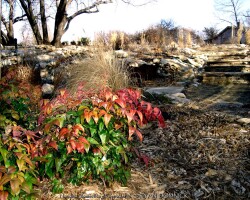

Nandina domestica is also called "Nandina" or "Heavenly Bamboo" despite not spreading or being related to bamboo at all. It is native to warm temperate climates in China. Bamboo-like foliage is very attractive with new growth emerging coppery peach with shades of pink and red in spring. During the summer, the foliage maintains a glossy deep to medium green color with no pest problems. White flowers appear which eventually turn into red fruits in the fall. Most birds do not like the fruit so they persist very well into winter down to about 0° F before freeze-drying to a reddish brown color and falling off. Often around Christmas time, the berries make a spectacular show combining classic colors of red and green in the winter landscape. The berries can be poisonous to some birds if they eat too many and all other food sources are depleted. This is a problem in your yard, please remove the fruits in the winter or before we have an arctic blast in which birds get desperate and will eat anything. The foliage is evergreen down to about -5° F and if colder, will simply become a deciduous shrub that year. If winter temperatures reach -10 or with strong winds, nandina will die to the ground like a perennial and come up from the base in April. In some parts of the country where winterkill never happens, nandina are invasive. (fruits spread by birds) This is likely in the Southeast and Texas south of zone 8b with plenty of rainfall. In those areas nandina will slowly take over the forest and displace native plants. There are many fruitless cultivars that can be used if invasiveness is a problem. In Kansas and in zone 5-7, This is never a problem because extreme winters keep the plant "in-check" and kill any seedlings trying to germinate. This shrub has a four-season appeal and is great for adding interest to Kansas landscapes in the winter. Best growth in Lawrence, KS (zone 6a) occurs when planted on South or West exposures benefiting from the hot micro climate. Nandina will also grow in just about any soil with full shade to full sun. If planted in full shade, growth will be very slow and extreme winters may kill them if not established; plant in spring only in this situation. Nandina look best in small to large groups. After established, its a "once it's there it's there forever" plant with very little maintenance. The only maintenance is cutting back winter kill occasionally or pruning to a more desirable mounded shape. It is worth noting that dwarf fruitless cultivars are less hardy in marginal zone 6 climates because of reduced ability to quickly recover from an occasional extreme winter. However, Nandina domestica 'Firepower' seems to persist well here!
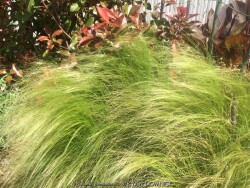

Mexican Feather Grass (Nassella tenuissima) has fine hair-like foliage is bright green in summer turning a beige buff color in winter. Delicate and graceful leaves and airy flower heads sway gently with the slightest breeze. Whispy but sturdy seed heads hold up well through winter. Mexican Feather Grass is a short grass native to rocky open slopes, dry woods with shallow rocky soils and grasslands. This is one of a few plants to occur naturally in southwestern North America (including northern Mexico) and in southern South America with no natural populations in between. Normally plant populations with this much isolation would evolve into separate species! Plants adapt to a wide range of conditions and can be invasive in California but never in Kansas. Typical landscape uses in Kansas are as follows: annual plantings, parking lot islands, hot West and South exposures, south facing berms, and xeriscape gardens. It will thrive in most soils but not poor drainage. When used as an annual, it creates an amazing contrast with other flowers. If low temperatures hit -10 degrees F, it may kill an un-mulched plant; protect any zone 6 perennial with thick layer of mulch. However, in our trial gardens in Lawrence, KS (zone 6a), several established specimens survived -17 degrees F. During the arctic blast of February, 2021, lows down to -17 degrees F on Feb 16th, 2021 were recorded. The longevity of this cold blast was also impressive: 10 days on a row with highs of 10-15 degrees F or lower, 8 nights of lows in the single digits and negatives, and 36 strait hours of 0 degrees F and mostly lower.
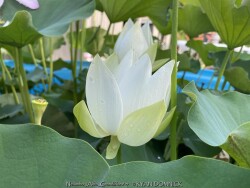

Alba Grandiflora Water Lotus, is also known as Nelumbo 'Alba Grandiflora'
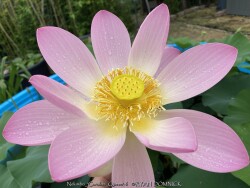

Carolina Queen Pink Water Lotus, is also known as Nelumbo 'Carolina Queen'
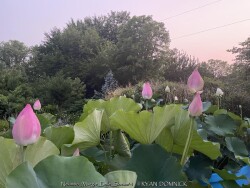

Maggie Belle Slocum Pink Water Lotus, is also known as Nelumbo 'Maggie Belle Slocum'


Perrys Giant Sunburst Light Yellow Water Lotus, is also known as Nelumbo 'Perrys Giant Sunburst'
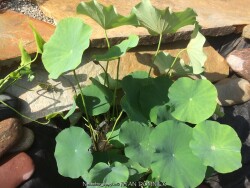

American Native Water Lotus, is also known as Nelumbo lutea
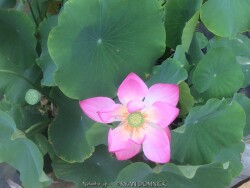

Water Lotus Cultivars (mixed), is also known as Nelumbo sp.
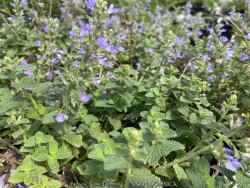

Nepeta (Catmint) Is one of the most adaptable, permanent perennials available in our climate and in your landscape! Definitely a "once it's their plant if there forever". Originally native to the Caucasus, Iran, Iraq, Turkey, there are numerous cultivars now with improved flowering and growth habit. Generally, the mint green foliage is fine textured and compact. Spring emergence in Kansas zone 6a is very early (usually in March) and will tolerate late freezes. This creates very early season interest in the garden while other plants are still dormant. Usually within a month of emerging, lavender-blue flowers cover the plant for up to six weeks. Pollinators enjoy the feast especially when catmint is used as a mass planting groundcover. Following spring flowering, many varieties develop attractive foliage and continual sporadic flowering. Some varieties have another big flower show in the fall especially if they are trimmed back and deadheaded once in late summer. Foliage is persistent and remains attractive late into the fall down to about 20° F providing late-season interest. Winter dried foliage is a somewhat attractive light gray and will eventually need to be cut or mowed to the ground before new growth emerges in the spring. Catmint is tolerant of almost any kind of soil including clay but will not tolerate poorly drained soil. Frequent watering is OK in normal garden soils but there is a risk of excessive growth and flopping. Catmint looks best in full sun but will still flower and look decent with part shade or 1/2 day full sun. This makes it adaptable to any side of the house even called northside if it gets full sun by mid-summer when the sun angle gets high. Cold hardiness or heat stress is not a problem at all in zone 6. Combine with just about any other perennial or shrub with a different flower and leaf color. It's hard to imagine a perennial or pollinator garden in Kansas without Catmint! Contrary to popular belief, cats do not destroy or eat this plant but may be attracted to it and create a nest beside it. They are really after catnip, a closely related plant. Nepeta 'Cat's Pajamas' is a long blooming perennial that's perfect in small areas of the landscape. Indigo blue flowers are produced all the way from the soil to the tips, providing an intense splash of color when it's in bloom. Rosy purple calyxes extend the color when the blooms are past peak. All Proven Winners® plants are legally propagated, healthy and vigorous, true to name, and tagged with color pictures and growing information.
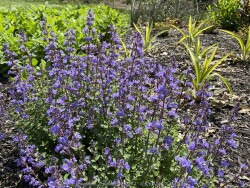

Nepeta (Catmint) Is one of the most adaptable, permanent perennials available in our climate and in your landscape! Definitely a "once it's their plant if there forever". Originally native to the Caucasus, Iran, Iraq, Turkey, there are numerous cultivars now with improved flowering and growth habit. Generally, the mint green foliage is fine textured and compact. Spring emergence in Kansas zone 6a is very early (usually in March) and will tolerate late freezes. This creates very early season interest in the garden while other plants are still dormant. Usually within a month of emerging, lavender-blue flowers cover the plant for up to six weeks. Pollinators enjoy the feast especially when catmint is used as a mass planting groundcover. Following spring flowering, many varieties develop attractive foliage and continual sporadic flowering. Some varieties have another big flower show in the fall especially if they are trimmed back and deadheaded once in late summer. Foliage is persistent and remains attractive late into the fall down to about 20° F providing late-season interest. Winter dried foliage is a somewhat attractive light gray and will eventually need to be cut or mowed to the ground before new growth emerges in the spring. Catmint is tolerant of almost any kind of soil including clay but will not tolerate poorly drained soil. Frequent watering is OK in normal garden soils but there is a risk of excessive growth and flopping. Catmint looks best in full sun but will still flower and look decent with part shade or 1/2 day full sun. This makes it adaptable to any side of the house even called northside if it gets full sun by mid-summer when the sun angle gets high. Cold hardiness or heat stress is not a problem at all in zone 6. Combine with just about any other perennial or shrub with a different flower and leaf color. It's hard to imagine a perennial or pollinator garden in Kansas without Catmint! Contrary to popular belief, cats do not destroy or eat this plant but may be attracted to it and create a nest beside it. They are really after catnip, a closely related plant. Nepeta grandiflora 'Summer Magic' is a free-blooming catmint that lives up to its namesake€â€it is summer magic! It blooms all season long on upright stems that never flop, even in the worst of storms. It stays fresh looking even in the heat and humidity of summer as other nepeta varieties tend to fade.
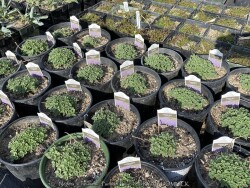

Nepeta (Catmint) Is one of the most adaptable, permanent perennials available in our climate and in your landscape! Definitely a "once it's their plant if there forever". Originally native to the Caucasus, Iran, Iraq, Turkey, there are numerous cultivars now with improved flowering and growth habit. Generally, the mint green foliage is fine textured and compact. Spring emergence in Kansas zone 6a is very early (usually in March) and will tolerate late freezes. This creates very early season interest in the garden while other plants are still dormant. Usually within a month of emerging, lavender-blue flowers cover the plant for up to six weeks. Pollinators enjoy the feast especially when catmint is used as a mass planting groundcover. Following spring flowering, many varieties develop attractive foliage and continual sporadic flowering. Some varieties have another big flower show in the fall especially if they are trimmed back and deadheaded once in late summer. Foliage is persistent and remains attractive late into the fall down to about 20° F providing late-season interest. Winter dried foliage is a somewhat attractive light gray and will eventually need to be cut or mowed to the ground before new growth emerges in the spring. Catmint is tolerant of almost any kind of soil including clay but will not tolerate poorly drained soil. Frequent watering is OK in normal garden soils but there is a risk of excessive growth and flopping. Catmint looks best in full sun but will still flower and look decent with part shade or 1/2 day full sun. This makes it adaptable to any side of the house even called northside if it gets full sun by mid-summer when the sun angle gets high. Cold hardiness or heat stress is not a problem at all in zone 6. Combine with just about any other perennial or shrub with a different flower and leaf color. It's hard to imagine a perennial or pollinator garden in Kansas without Catmint! Contrary to popular belief, cats do not destroy or eat this plant but may be attracted to it and create a nest beside it. They are really after catnip, a closely related plant.
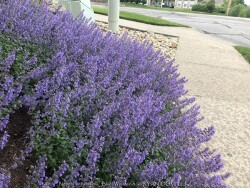

Nepeta (Catmint) Is one of the most adaptable, permanent perennials available in our climate and in your landscape! Definitely a "once it's their plant if there forever". Originally native to the Caucasus, Iran, Iraq, Turkey, there are numerous cultivars now with improved flowering and growth habit. Generally, the mint green foliage is fine textured and compact. Spring emergence in Kansas zone 6a is very early (usually in March) and will tolerate late freezes. This creates very early season interest in the garden while other plants are still dormant. Usually within a month of emerging, lavender-blue flowers cover the plant for up to six weeks. Pollinators enjoy the feast especially when catmint is used as a mass planting groundcover. Following spring flowering, many varieties develop attractive foliage and continual sporadic flowering. Some varieties have another big flower show in the fall especially if they are trimmed back and deadheaded once in late summer. Foliage is persistent and remains attractive late into the fall down to about 20° F providing late-season interest. Winter dried foliage is a somewhat attractive light gray and will eventually need to be cut or mowed to the ground before new growth emerges in the spring. Catmint is tolerant of almost any kind of soil including clay but will not tolerate poorly drained soil. Frequent watering is OK in normal garden soils but there is a risk of excessive growth and flopping. Catmint looks best in full sun but will still flower and look decent with part shade or 1/2 day full sun. This makes it adaptable to any side of the house even called northside if it gets full sun by mid-summer when the sun angle gets high. Cold hardiness or heat stress is not a problem at all in zone 6. Combine with just about any other perennial or shrub with a different flower and leaf color. It's hard to imagine a perennial or pollinator garden in Kansas without Catmint! Contrary to popular belief, cats do not destroy or eat this plant but may be attracted to it and create a nest beside it. They are really after catnip, a closely related plant. Nepeta x faassenii 'Blue Wonder' flowers that are a shade closer to blue. It will form low mounds of slightly greener leaves than most catmint. It may self-seed in optimum growing conditions in Kansas.


Nepeta (Catmint) Is one of the most adaptable, permanent perennials available in our climate and in your landscape! Definitely a "once it's their plant if there forever". Originally native to the Caucasus, Iran, Iraq, Turkey, there are numerous cultivars now with improved flowering and growth habit. Generally, the mint green foliage is fine textured and compact. Spring emergence in Kansas zone 6a is very early (usually in March) and will tolerate late freezes. This creates very early season interest in the garden while other plants are still dormant. Usually within a month of emerging, lavender-blue flowers cover the plant for up to six weeks. Pollinators enjoy the feast especially when catmint is used as a mass planting groundcover. Following spring flowering, many varieties develop attractive foliage and continual sporadic flowering. Some varieties have another big flower show in the fall especially if they are trimmed back and deadheaded once in late summer. Foliage is persistent and remains attractive late into the fall down to about 20° F providing late-season interest. Winter dried foliage is a somewhat attractive light gray and will eventually need to be cut or mowed to the ground before new growth emerges in the spring. Catmint is tolerant of almost any kind of soil including clay but will not tolerate poorly drained soil. Frequent watering is OK in normal garden soils but there is a risk of excessive growth and flopping. Catmint looks best in full sun but will still flower and look decent with part shade or 1/2 day full sun. This makes it adaptable to any side of the house even called northside if it gets full sun by mid-summer when the sun angle gets high. Cold hardiness or heat stress is not a problem at all in zone 6. Combine with just about any other perennial or shrub with a different flower and leaf color. It's hard to imagine a perennial or pollinator garden in Kansas without Catmint! Contrary to popular belief, cats do not destroy or eat this plant but may be attracted to it and create a nest beside it. They are really after catnip, a closely related plant. Nepeta x faassenii 'Cats Meow' in a new variety from Proven Winners® No catmint is a more beautiful, uniform grower than 'Cat's Meow' Nepeta. Its flowers are dense and colorful, and its habit is more refined. Plus, it stands strong with no flopping, getting wider and growing to a broad mound as the season progresses. All Proven Winners® plants are legally propagated, healthy and vigorous, true to name, and tagged with color pictures and growing information.
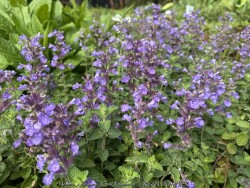

Nepeta (Catmint) Is one of the most adaptable, permanent perennials available in our climate and in your landscape! Definitely a "once it's their plant if there forever". Originally native to the Caucasus, Iran, Iraq, Turkey, there are numerous cultivars now with improved flowering and growth habit. Generally, the mint green foliage is fine textured and compact. Spring emergence in Kansas zone 6a is very early (usually in March) and will tolerate late freezes. This creates very early season interest in the garden while other plants are still dormant. Usually within a month of emerging, lavender-blue flowers cover the plant for up to six weeks. Pollinators enjoy the feast especially when catmint is used as a mass planting groundcover. Following spring flowering, many varieties develop attractive foliage and continual sporadic flowering. Some varieties have another big flower show in the fall especially if they are trimmed back and deadheaded once in late summer. Foliage is persistent and remains attractive late into the fall down to about 20° F providing late-season interest. Winter dried foliage is a somewhat attractive light gray and will eventually need to be cut or mowed to the ground before new growth emerges in the spring. Catmint is tolerant of almost any kind of soil including clay but will not tolerate poorly drained soil. Frequent watering is OK in normal garden soils but there is a risk of excessive growth and flopping. Catmint looks best in full sun but will still flower and look decent with part shade or 1/2 day full sun. This makes it adaptable to any side of the house even called northside if it gets full sun by mid-summer when the sun angle gets high. Cold hardiness or heat stress is not a problem at all in zone 6. Combine with just about any other perennial or shrub with a different flower and leaf color. It's hard to imagine a perennial or pollinator garden in Kansas without Catmint! Contrary to popular belief, cats do not destroy or eat this plant but may be attracted to it and create a nest beside it. They are really after catnip, a closely related plant. Nepeta x faassenii 'Cats Pajamas' in a new variety from Proven Winners® Unlike older varieties that only produce flowers at the top of the stems, this improved Catmint has blooms from the soil to the tips of the stems. Even when the flowers are past peak, the color of the rosy purple calyxes give your garden an additional splash of color. Compared to "Cats Meow", its flowers are the same but overall plant height is about 1/2-2/3rds. Plus, it stands strong with no flopping, getting wider and growing to a broad mound as the season progresses. All Proven Winners® plants are legally propagated, healthy and vigorous, true to name, and tagged with color pictures and growing information. PERENNIAL OF THE YEAR in 2021!
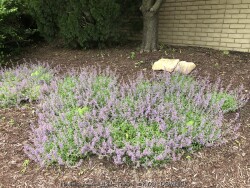

Nepeta (Catmint) Is one of the most adaptable, permanent perennials available in our climate and in your landscape! Definitely a "once it's their plant if there forever". Originally native to the Caucasus, Iran, Iraq, Turkey, there are numerous cultivars now with improved flowering and growth habit. Generally, the mint green foliage is fine textured and compact. Spring emergence in Kansas zone 6a is very early (usually in March) and will tolerate late freezes. This creates very early season interest in the garden while other plants are still dormant. Usually within a month of emerging, lavender-blue flowers cover the plant for up to six weeks. Pollinators enjoy the feast especially when catmint is used as a mass planting groundcover. Following spring flowering, many varieties develop attractive foliage and continual sporadic flowering. Some varieties have another big flower show in the fall especially if they are trimmed back and deadheaded once in late summer. Foliage is persistent and remains attractive late into the fall down to about 20° F providing late-season interest. Winter dried foliage is a somewhat attractive light gray and will eventually need to be cut or mowed to the ground before new growth emerges in the spring. Catmint is tolerant of almost any kind of soil including clay but will not tolerate poorly drained soil. Frequent watering is OK in normal garden soils but there is a risk of excessive growth and flopping. Catmint looks best in full sun but will still flower and look decent with part shade or 1/2 day full sun. This makes it adaptable to any side of the house even called northside if it gets full sun by mid-summer when the sun angle gets high. Cold hardiness or heat stress is not a problem at all in zone 6. Combine with just about any other perennial or shrub with a different flower and leaf color. It's hard to imagine a perennial or pollinator garden in Kansas without Catmint! Contrary to popular belief, cats do not destroy or eat this plant but may be attracted to it and create a nest beside it. They are really after catnip, a closely related plant. Nepeta x faassenii 'Little Trudy' is a compact, long-blooming catmint only 8-10" tall.
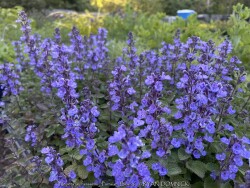

Nepeta (Catmint) Is one of the most adaptable, permanent perennials available in our climate and in your landscape! Definitely a "once it's their plant if there forever". Originally native to the Caucasus, Iran, Iraq, Turkey, there are numerous cultivars now with improved flowering and growth habit. Generally, the mint green foliage is fine textured and compact. Spring emergence in Kansas zone 6a is very early (usually in March) and will tolerate late freezes. This creates very early season interest in the garden while other plants are still dormant. Usually within a month of emerging, lavender-blue flowers cover the plant for up to six weeks. Pollinators enjoy the feast especially when catmint is used as a mass planting groundcover. Following spring flowering, many varieties develop attractive foliage and continual sporadic flowering. Some varieties have another big flower show in the fall especially if they are trimmed back and deadheaded once in late summer. Foliage is persistent and remains attractive late into the fall down to about 20° F providing late-season interest. Winter dried foliage is a somewhat attractive light gray and will eventually need to be cut or mowed to the ground before new growth emerges in the spring. Catmint is tolerant of almost any kind of soil including clay but will not tolerate poorly drained soil. Frequent watering is OK in normal garden soils but there is a risk of excessive growth and flopping. Catmint looks best in full sun but will still flower and look decent with part shade or 1/2 day full sun. This makes it adaptable to any side of the house even called northside if it gets full sun by mid-summer when the sun angle gets high. Cold hardiness or heat stress is not a problem at all in zone 6. Combine with just about any other perennial or shrub with a different flower and leaf color. It's hard to imagine a perennial or pollinator garden in Kansas without Catmint! Contrary to popular belief, cats do not destroy or eat this plant but may be attracted to it and create a nest beside it. They are really after catnip, a closely related plant. Nepeta faassenii 'Purrsian Blue' was introduced by Walter's Garden, Inc. This selection has an improved tidy habit, though it is a bit smaller and more compact in size overall than others. This is a very floriferous selection whose flower power is amplified by its having its flowers spaced closely together on the stems. Periwinkle blue flowers are coddled by dark purple calyxes just above the aromatic foliage from early summer into early fall.
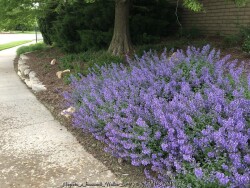

Nepeta (Catmint) Is one of the most adaptable, permanent perennials available in our climate and in your landscape! Definitely a "once it's their plant if there forever". Originally native to the Caucasus, Iran, Iraq, Turkey, there are numerous cultivars now with improved flowering and growth habit. Generally, the mint green foliage is fine textured and compact. Spring emergence in Kansas zone 6a is very early (usually in March) and will tolerate late freezes. This creates very early season interest in the garden while other plants are still dormant. Usually within a month of emerging, lavender-blue flowers cover the plant for up to six weeks. Pollinators enjoy the feast especially when catmint is used as a mass planting groundcover. Following spring flowering, many varieties develop attractive foliage and continual sporadic flowering. Some varieties have another big flower show in the fall especially if they are trimmed back and deadheaded once in late summer. Foliage is persistent and remains attractive late into the fall down to about 20° F providing late-season interest. Winter dried foliage is a somewhat attractive light gray and will eventually need to be cut or mowed to the ground before new growth emerges in the spring. Catmint is tolerant of almost any kind of soil including clay but will not tolerate poorly drained soil. Frequent watering is OK in normal garden soils but there is a risk of excessive growth and flopping. Catmint looks best in full sun but will still flower and look decent with part shade or 1/2 day full sun. This makes it adaptable to any side of the house even called northside if it gets full sun by mid-summer when the sun angle gets high. Cold hardiness or heat stress is not a problem at all in zone 6. Combine with just about any other perennial or shrub with a different flower and leaf color. It's hard to imagine a perennial or pollinator garden in Kansas without Catmint! Contrary to popular belief, cats do not destroy or eat this plant but may be attracted to it and create a nest beside it. They are really after catnip, a closely related plant. Nepeta x faassenii 'Walker Jr' is a compact, long-blooming catmint only 12-16" tall.
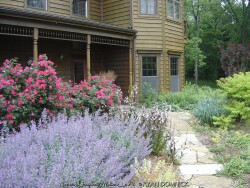

Nepeta (Catmint) Is one of the most adaptable, permanent perennials available in our climate and in your landscape! Definitely a "once it's their plant if there forever". Originally native to the Caucasus, Iran, Iraq, Turkey, there are numerous cultivars now with improved flowering and growth habit. Generally, the mint green foliage is fine textured and compact. Spring emergence in Kansas zone 6a is very early (usually in March) and will tolerate late freezes. This creates very early season interest in the garden while other plants are still dormant. Usually within a month of emerging, lavender-blue flowers cover the plant for up to six weeks. Pollinators enjoy the feast especially when catmint is used as a mass planting groundcover. Following spring flowering, many varieties develop attractive foliage and continual sporadic flowering. Some varieties have another big flower show in the fall especially if they are trimmed back and deadheaded once in late summer. Foliage is persistent and remains attractive late into the fall down to about 20° F providing late-season interest. Winter dried foliage is a somewhat attractive light gray and will eventually need to be cut or mowed to the ground before new growth emerges in the spring. Catmint is tolerant of almost any kind of soil including clay but will not tolerate poorly drained soil. Frequent watering is OK in normal garden soils but there is a risk of excessive growth and flopping. Catmint looks best in full sun but will still flower and look decent with part shade or 1/2 day full sun. This makes it adaptable to any side of the house even called northside if it gets full sun by mid-summer when the sun angle gets high. Cold hardiness or heat stress is not a problem at all in zone 6. Combine with just about any other perennial or shrub with a different flower and leaf color. It's hard to imagine a perennial or pollinator garden in Kansas without Catmint! Contrary to popular belief, cats do not destroy or eat this plant but may be attracted to it and create a nest beside it. They are really after catnip, a closely related plant. Nepeta x faassenii 'Walker's Low' is contradictorily a "tall" mounding plant grows to 2 to 3 feet tall and wide. If you want a very robust death-proof catmint, this is the one. I have also seen this plant effectively covering large sloped areas along roads with no bare spots or dead plants. Excellent when cascading off walls or container edges.


Nepeta (Catmint) Is one of the most adaptable, permanent perennials available in our climate and in your landscape! Definitely a "once it's their plant if there forever". Originally native to the Caucasus, Iran, Iraq, Turkey, there are numerous cultivars now with improved flowering and growth habit. Generally, the mint green foliage is fine textured and compact. Spring emergence in Kansas zone 6a is very early (usually in March) and will tolerate late freezes. This creates very early season interest in the garden while other plants are still dormant. Usually within a month of emerging, lavender-blue flowers cover the plant for up to six weeks. Pollinators enjoy the feast especially when catmint is used as a mass planting groundcover. Following spring flowering, many varieties develop attractive foliage and continual sporadic flowering. Some varieties have another big flower show in the fall especially if they are trimmed back and deadheaded once in late summer. Foliage is persistent and remains attractive late into the fall down to about 20° F providing late-season interest. Winter dried foliage is a somewhat attractive light gray and will eventually need to be cut or mowed to the ground before new growth emerges in the spring. Catmint is tolerant of almost any kind of soil including clay but will not tolerate poorly drained soil. Frequent watering is OK in normal garden soils but there is a risk of excessive growth and flopping. Catmint looks best in full sun but will still flower and look decent with part shade or 1/2 day full sun. This makes it adaptable to any side of the house even called northside if it gets full sun by mid-summer when the sun angle gets high. Cold hardiness or heat stress is not a problem at all in zone 6. Combine with just about any other perennial or shrub with a different flower and leaf color. It's hard to imagine a perennial or pollinator garden in Kansas without Catmint! Contrary to popular belief, cats do not destroy or eat this plant but may be attracted to it and create a nest beside it. They are really after catnip, a closely related plant.
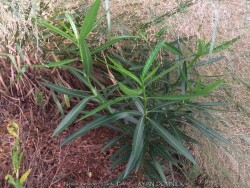

Austin Pretty Limits® Oleander. (Nerium oleander 'Austin Pretty Limits') Enjoy bright pink flowers every day of the year with Austin Pretty Limits oleander. This non-stop bloomer was selected in Austin, Texas, for its dense, rounded habit and exceptional disease resistance. The bright pink flowers make it the ideal choice for hedges, specimens, containers, and more. Oleander is typically grown in warmer zones. Along with other tropicals and succulents in Kansas, oleander is usually grown as summer patio plant. Water regularly and place in full sun. Protect from temperatures below 25 degrees F and move into a bright window, cold garage or basement over the winter with monthly watering. Do not allow the pot with rootball to freeze solid or go below 20 degrees F for more than a few hours. Allow to go dormant as needed with little care, just cut off dead foliage and place back out in April or May with a time-release fertilizer. Many plants will die back slowly inside but still remain attractive inside for most of the winter. You may also plant these in the ground for an enormous tropical effect! It is possible to overwinter these in the ground in Kansas by placing a giant 12-18" mound of mulch over plants and position on the South side of a house. Note: like all oleanders, this plant is toxic if ingested. All Proven Winners® plants are legally propagated, healthy and vigorous, true to name, and tagged with color pictures and growing information.
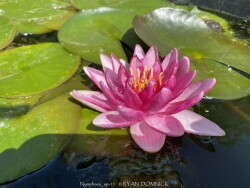

Attraction Red Water Lily, is also known as Nymphaea 'Attraction'
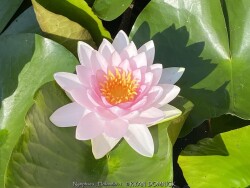

Hollandia Pink Water Lily, is also known as Nymphaea 'Hollandia'


Moon Dance White Water Lily, is also known as Nymphaea 'Moon Dance'
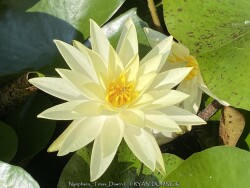

Texas Dawn Yellow Water Lily, is also known as Nymphaea 'Texas Dawn'


Mixed Water Lily Cultivars, is also known as Nymphaea sp.
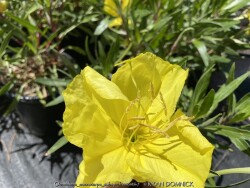

Kansas Native Missouri Primrose, is also known as Oenothera macrocarpa subsp. fremontii
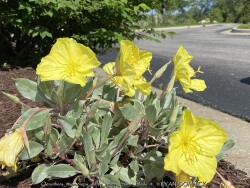

Silver Blade Missouri Primrose, is also known as Oenothera macrocarpa subsp. incana 'Silver Blade'
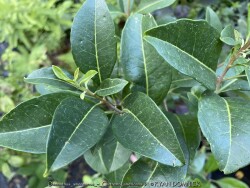

Devilwood (Osmanthus americanus / Cartrema americana) has very hard and dense wood, hence the name. It is a slow-growing evergreen shrub or small tree native to southeastern North America and Mexico. Bright green simple leaves emerge in spring turning deeper green in summer. Cream white flowers borne on separate trees and female trees produce abundant blue/black fruit. Growth habit is somewhat open so don't count on it to provide screening or density. Grows in sun or shade but in the northern part of its range, growth is too slow and sparse in the shade. Devilwood grows in most soils including moist ones and occasional flooding. This making it an ideal rain garden plant. Becoming more drought tolerant when established, our 40 inches of typical rainfall in Eastern Kansas is sufficient if planted in good soils. The cold hardiness is surprising: as a zone 5, this could be one of the most cold-tolerant broadleaf evergreens trees available! It survived -16 degrees F and a week of single digit highs in February, 2021 with no damage. It even maintains bright green foliage in winter opposed to a dingy brownish-green like some evergreens. Useful in the garden as a background evergreen shrub or small tree. Sold as Osmanthus americanus, Cartrema americana is technically it's new botanical name.
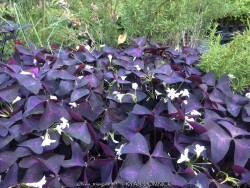

Oxalis triangularis is also commonly called Purple False Shamrock. It is a species of perennial plant native to several countries in southern South America. Grown mostly for its bright purple shamrock-like leaves and occasional pink flowers, the leaves also move in response to light levels, opening in high ambient light (in the day) and closing at low light levels (at night) In Kansas gardens it is normally grown in containers as an annual, patio plant or house plant. If grown in well drained soil planted in the ground in the right micro-climate (South-facing exposure), it may be a perennial. If low temperatures hit -10 degrees F, it may kill an un-mulched plant; protect any zone 6 perennial with thick layer of mulch. In our trial gardens in Lawrence, KS (zone 6a), three established specimens planted 3-4" deep and mulched 4-6" with leaf mulch survived -17 degrees F. During the arctic blast of February, 2021, lows down to -17 degrees F on Feb 16th, 2021 were recorded. The longevity of this cold blast was also impressive: 10 days on a row with highs of 10-15 degrees F or lower, 8 nights of lows in the single digits and negatives, and 36 straight hours of 0 degrees F and mostly lower. More testing would be good to evaluate true cold-tolerance.


Green Sheen Japanese Pachysandra, is also known as Pachysandra terminalis 'Green Sheen'
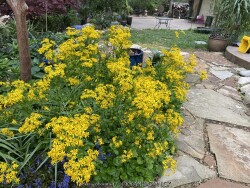

Native Roundleaf Groundsel / Packera, is also known as Packera obovata
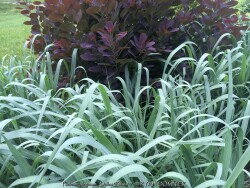

Dallas Blues Switch Grass, is also known as Panicum virgatum 'Dallas Blues'
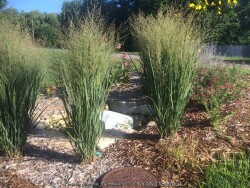

Northwinds Switch Grass, is also known as Panicum virgatum 'Northwinds'
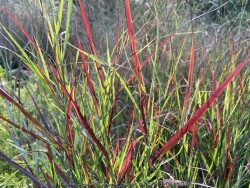

>>>>>Forms a dense, upright clump of blue-green leaves that turn wine red in early summer. Purple flower panicles appear just above the foliage in late summer. This petite red grass is ideal for containers.>>>>>>All Proven Winners® plants are legally propagated, healthy and vigorous, true to name, and tagged with color pictures and growing information.
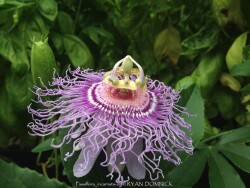

Hardy Purple Passionflower (Passiflora incarnata) is also called Maypop and is native to the eastern United States including Kansas. The plant features dark green tri-lobed leaves and tropical-looking purple and white flowers. The petals and sepals include a fringe of wavy or crimped hair-like segments with very pronounced pistils and stamens. Flowers bloom in summer and are fragrant. Fleshy, egg-shaped, edible fruits called maypops appear in July-August and mature to a yellowish color in fall. Ripened maypops can be eaten fresh off the vine or made into jelly. Maypop name refers to the loud popping sound made when fruits are stepped on. It's one of those "if you don't eat it, step on it plants"! Easily grown in a wide variety of soils including heavy clay. It is usually grown on structures that it can be easily removed from each year as it dies to the ground. We have it growing in our Lawrence, KS display garden mixed with a large patch of giant reed grass (Arundo donax) that all gets cut down each year. It weaves beautifully throughout the canes and allows for easy to harvest the fruits. Funny thing is, we did not plant it: it just showed up on its own. No other plants exist within several hundred feet! Beware that this is an extremely vigorous plant that crowds out most weeds and is itself weed-like, with a very spreading growth habit mainly from root suckers coming up freely. Best planted in wild areas where it can mix with other plants; mowing around it generally stops the yearly spread in lawn areas. Spot spraying errant shoots is also effective. "Once it's there, it's there forever" plant!
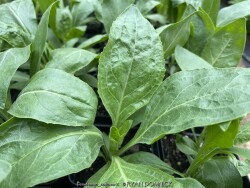

***Description for this perennial available with future update!***
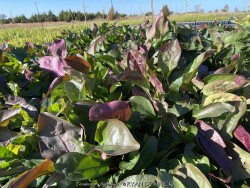

Foxglove Beardtongue / Native Penstemon, is also known as Penstemon digitalis. >>>>>
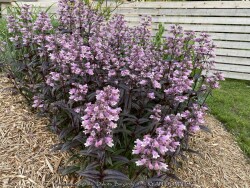

Dakota Burgundy Penstemon, is also known as Penstemon digitalis 'Dakota Burgundy'
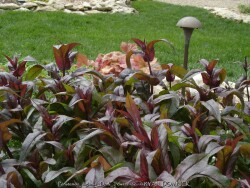

Dark Towers Penstemon, is also known as Penstemon digitalis 'Dark Towers'
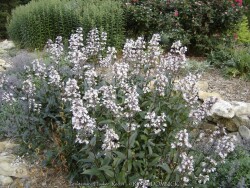

Husker Red Penstemon, is also known as Penstemon digitalis 'Husker Red'
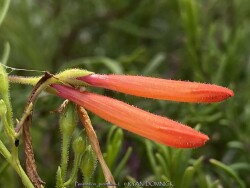

***Description for this perennial available with future update!***
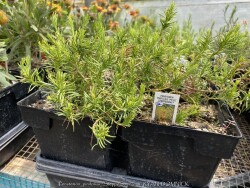

***Description for this perennial available with future update!***
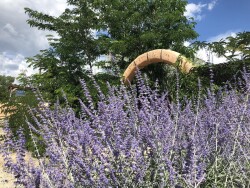

Russian sage (Perovskia atriplicifolia) is a perfectly well-adapted plant from Afghanistan, Pakistan, and Central Asia. It is the perfect match to hot Kansas summers, cold winters, rocky alkaline soils, and drought. Fine-textured foliage is upright and shrub-like consisting of a mint green to blush green color. Lavender to bluish flowers emerging in mid-summer are extremely long-lasting. In fall, Russian sage foliage dies back with the first hard freeze and becomes a whitish-gray color adding awesome winter interest. Imagine this combined with ornamental grasses or bright winter-colored plants like Color Guard Yucca. The only maintenance is cutting the plant back to you about 6 to 8 inches in the spring. New buds emerge from the root system and lower parts of the woody growth. New cultivars of Russian sage do not spread by rhizomes like the species. Russian sage thrives in dry well-drained soils with plenty of full sun and air circulation. They are suitable for hot west or south exposures, berms, parking lot islands, hell strips along roads, and other inhospitable locations. They tolerate poor soil including rock, sand, clay, and alkalinity. They do not tolerate poor drainage and will be floppy even in part shade. Russian sage flowers are highly attractive to honeybees. There are several improved cultivars with improved blooming, improved growth habit, and elimination of spreading.
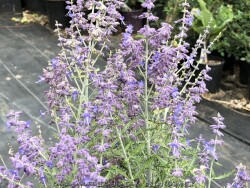

Russian sage (Perovskia atriplicifolia) is a perfectly well-adapted plant from Afghanistan, Pakistan, and Central Asia. It is the perfect match to hot Kansas summers, cold winters, rocky alkaline soils, and drought. Fine-textured foliage is upright and shrub-like consisting of a mint green to blush green color. Lavender to bluish flowers emerging in mid-summer are extremely long-lasting. In fall, Russian sage foliage dies back with the first hard freeze and becomes a whitish-gray color adding awesome winter interest. Imagine this combined with ornamental grasses or bright winter-colored plants like Color Guard Yucca. The only maintenance is cutting the plant back to you about 6 to 8 inches in the spring. New buds emerge from the root system and lower parts of the woody growth. New cultivars of Russian sage do not spread by rhizomes like the species. Russian sage thrives in dry well-drained soils with plenty of full sun and air circulation. They are suitable for hot west or south exposures, berms, parking lot islands, hell strips along roads, and other inhospitable locations. They tolerate poor soil including rock, sand, clay, and alkalinity. They do not tolerate poor drainage and will be floppy even in part shade. Russian sage flowers are highly attractive to honeybees. There are several improved cultivars with improved blooming, improved growth habit, and elimination of spreading. Blue Jean Baby Russian Sage (Perovskia atriplicifolia 'Blue Jean Baby') is a wonderful compact, non-spreading, and non-flopping variety. Lavender blue flowers held in smoky purple calyxes bloom for a long period starting in midsummer, with the color from the calyxes extending appeal into fall. Blue Jean Baby a Walters Gardens Inc. introduction.


Russian sage (Perovskia atriplicifolia) is a perfectly well-adapted plant from Afghanistan, Pakistan, and Central Asia. It is the perfect match to hot Kansas summers, cold winters, rocky alkaline soils, and drought. Fine-textured foliage is upright and shrub-like consisting of a mint green to blush green color. Lavender to bluish flowers emerging in mid-summer are extremely long-lasting. In fall, Russian sage foliage dies back with the first hard freeze and becomes a whitish-gray color adding awesome winter interest. Imagine this combined with ornamental grasses or bright winter-colored plants like Color Guard Yucca. The only maintenance is cutting the plant back to you about 6 to 8 inches in the spring. New buds emerge from the root system and lower parts of the woody growth. New cultivars of Russian sage do not spread by rhizomes like the species. Russian sage thrives in dry well-drained soils with plenty of full sun and air circulation. They are suitable for hot west or south exposures, berms, parking lot islands, hell strips along roads, and other inhospitable locations. They tolerate poor soil including rock, sand, clay, and alkalinity. They do not tolerate poor drainage and will be floppy even in part shade. Russian sage flowers are highly attractive to honeybees. There are several improved cultivars with improved blooming, improved growth habit, and elimination of spreading. "Tough as steel! A new seed introduction by PanAm Seed with a sturdy, controlled habit in the landscape. 'Blue Steel' combines the best summer-blooming lavender-blue colour with outstanding late-season garden performance and has aromatic, silvery foliage carrying clouds of small blue flowers on strong silver stems that do not break or split easily. It is very hardy and Heat/drought tolerant." - PanAm Seed
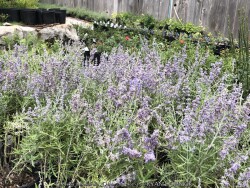

Russian sage (Perovskia atriplicifolia) is a perfectly well-adapted plant from Afghanistan, Pakistan, and Central Asia. It is the perfect match to hot Kansas summers, cold winters, rocky alkaline soils, and drought. Fine-textured foliage is upright and shrub-like consisting of a mint green to blush green color. Lavender to bluish flowers emerging in mid-summer are extremely long-lasting. In fall, Russian sage foliage dies back with the first hard freeze and becomes a whitish-gray color adding awesome winter interest. Imagine this combined with ornamental grasses or bright winter-colored plants like Color Guard Yucca. The only maintenance is cutting the plant back to you about 6 to 8 inches in the spring. New buds emerge from the root system and lower parts of the woody growth. New cultivars of Russian sage do not spread by rhizomes like the species. Russian sage thrives in dry well-drained soils with plenty of full sun and air circulation. They are suitable for hot west or south exposures, berms, parking lot islands, hell strips along roads, and other inhospitable locations. They tolerate poor soil including rock, sand, clay, and alkalinity. They do not tolerate poor drainage and will be floppy even in part shade. Russian sage flowers are highly attractive to honeybees. There are several improved cultivars with improved blooming, improved growth habit, and elimination of spreading. Denim 'n Lace Russian Sage(Perovskia atriplicifolia 'Denim 'n Lace') is a wonderful non-spreading, non-flopping variety. This is the perfect addition to a garden in hot, dry areas. Lacy-like, bright sky blue flowers are held on amethyst calyxes, with strong stems and an upright habit. The beautiful color will last a long time! All Proven Winners® plants are legally propagated, healthy and vigorous, true to name, and tagged with color pictures and growing information.
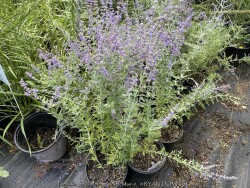

Russian sage (Perovskia atriplicifolia) is a perfectly well-adapted plant from Afghanistan, Pakistan, and Central Asia. It is the perfect match to hot Kansas summers, cold winters, rocky alkaline soils, and drought. Fine-textured foliage is upright and shrub-like consisting of a mint green to blush green color. Lavender to bluish flowers emerging in mid-summer are extremely long-lasting. In fall, Russian sage foliage dies back with the first hard freeze and becomes a whitish-gray color adding awesome winter interest. Imagine this combined with ornamental grasses or bright winter-colored plants like Color Guard Yucca. The only maintenance is cutting the plant back to you about 6 to 8 inches in the spring. New buds emerge from the root system and lower parts of the woody growth. New cultivars of Russian sage do not spread by rhizomes like the species. Russian sage thrives in dry well-drained soils with plenty of full sun and air circulation. They are suitable for hot west or south exposures, berms, parking lot islands, hell strips along roads, and other inhospitable locations. They tolerate poor soil including rock, sand, clay, and alkalinity. They do not tolerate poor drainage and will be floppy even in part shade. Russian sage flowers are highly attractive to honeybees. There are several improved cultivars with improved blooming, improved growth habit, and elimination of spreading. Here's a Russian Sage (Perovskia atriplicifolia 'Rocketman') that doesn't get too tall, has stronger stems and a more upright habit than most. Its aromatic, grey-green leaves are entirely like those of 'Little Spire', clinging to the silvery stems. Each stem is topped with large, fluffy textured, lavender blue flowers beginning in midsummer. Like most Perovskias, the colorful calyxes remain on the stems long after the flowers are spent, making it look like it is still blooming long after it is actually done. You'll have great color on this plant from about July through October in the Midwest. A perfect perennial for hot, dry climates and also exceptionally cold hardy. Perovskia can be used in a wide variety of environments with little attention through the season - a reason they have long been a staple of landscapers. Expect these plants to be a little later to emerge in spring, but also to offer color well into fall. Rocketman Russian Sage is a Walters Gardens Inc. introduction.
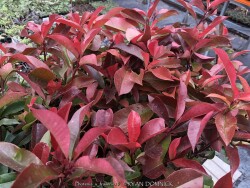

>>>>>Repeated or successive cold winters with complete foliage loss seem to be an issue with this and many evergreen zone 6/7 plants. One occasional difficult winter followed by mild winters is more tolerable. This is, however, a very vigorous growing plant so generally will recover in one summer with decent watering and fertilizer.